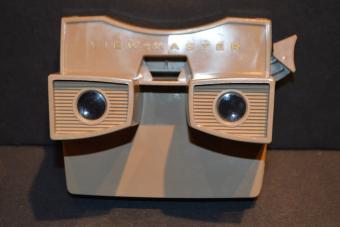
Long before we could see the other side of the world in three seconds with a quick internet search, kids and adults had the rotating slides of their bright red View Master to transport them in an instant. View Master actually has an origin that stretches back over 100 years, and it continues to be many kids' first gateway to the magical world around them. Take a deeper look at the vintage View Master and discover what makes it a beloved collectible today.
How Antique Stereoscopes Inspired Vintage View Masters

The View Master wasn't the first technology of its kind to take individual images and manipulate them into letting viewers see a 3D scene. Rather, you can thank your great-great-great-great grandparents for that.
Recreational photography saw a boon in the 19th century, where people could be entertained and enraptured by images of distant locales and naughty scenes. Yet, Charles Wheatstone, a British scientist, published his unique optical illusion findings in 1938. Basically, he discovered that if you put two images of the same scene from slightly different perspectives beside each other and looked at them, your brain would orient them into a three-dimensional image.
David Brewster took this concept about a decade later and developed a device that could hold these images for you to look at. Equipped with lenses and fitting in the palm of your hand, this stereoscope became one of the most popular at-home photographic tools in the 19th century.
People would continue to expand on this technology until Sawyer's Photo Services debuted their View Master at the 1939 New York World's Fair. Through the mid-century, stereoscope viewers shifted from being marketed for adults to being seen as a kids' toy. Hence, the bright colors and childish photo packs of our childhoods.
Different Vintage View Master Models You Might Have
With nearly 100 years of continuous production, the View Master has changed design several times. Here are some of the notable ones that your grandparents or parents might still have in boxes full of their childhood mementoes.
Model A 1938-1944
The Model A was the first View Master that was commercially available and opened up like a clamshell to put the rotating slides inside. Because it was made out of Kodak Tenite plastic, it's hard to find these circular viewers in pristine, unwarped condition.
Model B 1944-1947

Model B viewers are incredibly similar to Model As, though they were made out of bakelite instead of Kodak's plastic. They still opened like a clamshell and came in a variety of colors. Their particular finish gives them a dry-wet look often associated with scuba gear.
Model C 1946-1955

The Model C viewer was made out of bakelite and was the first one to come with a built-in slot to hold the picture reels. The black variant is the most common, while it came in other colors as well: dark brown, black and brown speckles, and two-tone brown.
Model D 1955-1972

One of the best-built vintage View Masters, Model Ds were made out of bakelite and came with focusing lenses. These mid-century viewers bear the name on the back and come in a more compact, square shape as opposed to the larger models from previous decades.
Model G 1959-1977

The first plastic models, Model G View Masters really take on that childish, toy-like design. Since they were made out of plastic, they could be created in bright color combinations like reds and blues. There were a ton of variations made during their run, with each one having their own specific value.
How Valuable Are Vintage View Masters?
Although rare View Masters can bring in a few hundred dollars, you will have to put in a little work finding the right buyer. They're a niche collectible, so sometimes you'll have to wait around to see when the perfect buyer will snap up your lot.
On average, View Masters from the 1950s-1960s can sell for about $50 each, so long as they're in good working condition. Out of the vintage models, Model D consistently sells for the most. You can get anywhere between $150-$500 depending on the buyer.
The real money lies in combining vintage View Masters with huge lots of vintage reels. The more reels you can find, the higher you'll be able to sell them for. For example, this Model D viewer and assorted lot of reels recently sold for $500 on eBay. Similarly, this vintage pack of National Park sightseeing reels sold for $218.50 online.
Ultimately, if you're hoping to strike gold on your vintage View Master from the 1980s, you might want to hold onto it for a little longer and let it age some more.
View Master Puts the Whole World in Your Hands
Even on rainy days, you can cruise through your favorite sights, or enjoy clips from your go-to childhood movies with a View Master. View Masters might not be as magical today as they were for us a few decades ago, but to the collectors who get their special appeal, these bad boys are worth a nice chunk of money.







